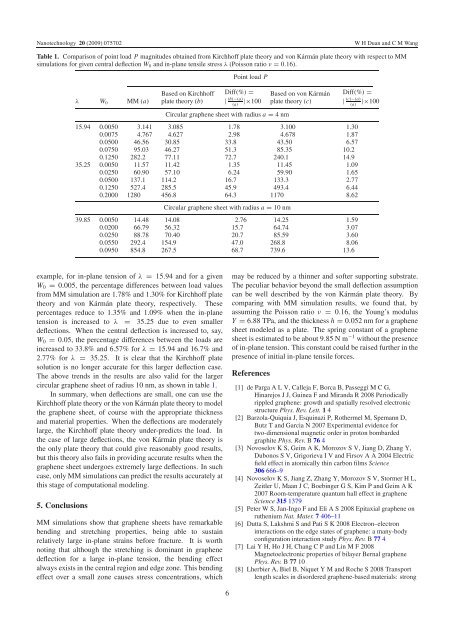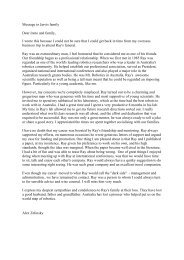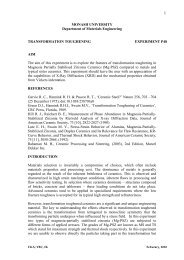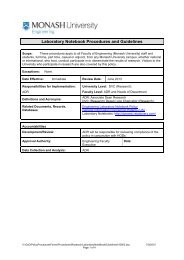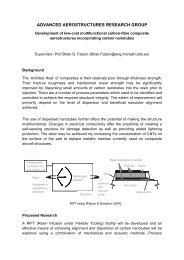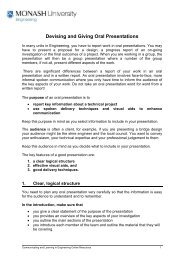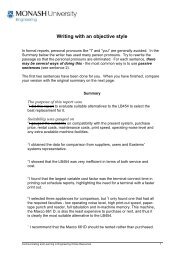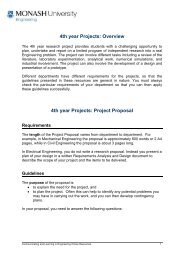Nonlinear bending and stretching of a circular graphene sheet ...
Nonlinear bending and stretching of a circular graphene sheet ...
Nonlinear bending and stretching of a circular graphene sheet ...
Create successful ePaper yourself
Turn your PDF publications into a flip-book with our unique Google optimized e-Paper software.
Nanotechnology 20 (2009) 075702W H Duan <strong>and</strong> C M WangTable 1. Comparison <strong>of</strong> point load P magnitudes obtained from Kirchh<strong>of</strong>f plate theory <strong>and</strong> von Kármán plate theory with respect to MMsimulations for given central deflection W 0 <strong>and</strong> in-plane tensile stress λ (Poisson ratio ν = 0.16).λ W 0 MM (a)Based on Kirchh<strong>of</strong>fplate theory (b)Point load PDiff(%) =| (b)−(a)(a)|×100Circular <strong>graphene</strong> <strong>sheet</strong> with radius a = 4nmBasedonvonKármánplate theory (c)15.94 0.0050 3.141 3.085 1.78 3.100 1.300.0075 4.767 4.627 2.98 4.678 1.870.0500 46.56 30.85 33.8 43.50 6.570.0750 95.03 46.27 51.3 85.35 10.20.1250 282.2 77.11 72.7 240.1 14.935.25 0.0050 11.57 11.42 1.35 11.45 1.090.0250 60.90 57.10 6.24 59.90 1.650.0500 137.1 114.2 16.7 133.3 2.770.1250 527.4 285.5 45.9 493.4 6.440.2000 1280 456.8 64.3 1170 8.62Circular <strong>graphene</strong> <strong>sheet</strong> with radius a = 10 nm39.85 0.0050 14.48 14.08 2.76 14.25 1.590.0200 66.79 56.32 15.7 64.74 3.070.0250 88.78 70.40 20.7 85.59 3.600.0550 292.4 154.9 47.0 268.8 8.060.0950 854.8 267.5 68.7 739.6 13.6Diff(%) =| (c)−(a)(a)|×100example, for in-plane tension <strong>of</strong> λ = 15.94 <strong>and</strong> for a givenW 0 = 0.005, the percentage differences between load valuesfrom MM simulation are 1.78% <strong>and</strong> 1.30% for Kirchh<strong>of</strong>f platetheory <strong>and</strong> von Kármán plate theory, respectively. Thesepercentages reduce to 1.35% <strong>and</strong> 1.09% when the in-planetension is increased to λ = 35.25 due to even smallerdeflections. When the central deflection is increased to, say,W 0 = 0.05, the percentage differences between the loads areincreased to 33.8% <strong>and</strong> 6.57% for λ = 15.94 <strong>and</strong> 16.7% <strong>and</strong>2.77% for λ = 35.25. It is clear that the Kirchh<strong>of</strong>f platesolution is no longer accurate for this larger deflection case.The above trends in the results are also valid for the larger<strong>circular</strong> <strong>graphene</strong> <strong>sheet</strong> <strong>of</strong> radius 10 nm, as shown in table 1.In summary, when deflections are small, one can use theKirchh<strong>of</strong>f plate theory or the von Kármán plate theory to modelthe <strong>graphene</strong> <strong>sheet</strong>, <strong>of</strong> course with the appropriate thickness<strong>and</strong> material properties. When the deflections are moderatelylarge, the Kirchh<strong>of</strong>f plate theory under-predicts the load. Inthe case <strong>of</strong> large deflections, the von Kármán plate theory isthe only plate theory that could give reasonably good results,but this theory also fails in providing accurate results when the<strong>graphene</strong> <strong>sheet</strong> undergoes extremely large deflections. In suchcase, only MM simulations can predict the results accurately atthis stage <strong>of</strong> computational modeling.5. ConclusionsMM simulations show that <strong>graphene</strong> <strong>sheet</strong>s have remarkable<strong>bending</strong> <strong>and</strong> <strong>stretching</strong> properties, being able to sustainrelatively large in-plane strains before fracture. It is worthnoting that although the <strong>stretching</strong> is dominant in <strong>graphene</strong>deflection for a large in-plane tension, the <strong>bending</strong> effectalways exists in the central region <strong>and</strong> edge zone. This <strong>bending</strong>effect over a small zone causes stress concentrations, whichmay be reduced by a thinner <strong>and</strong> s<strong>of</strong>ter supporting substrate.The peculiar behavior beyond the small deflection assumptioncan be well described by the von Kármán plate theory. Bycomparing with MM simulation results, we found that, byassuming the Poisson ratio ν = 0.16, the Young’s modulusY = 6.88 TPa, <strong>and</strong> the thickness h = 0.052 nm for a <strong>graphene</strong><strong>sheet</strong> modeled as a plate. The spring constant <strong>of</strong> a <strong>graphene</strong><strong>sheet</strong> is estimated to be about 9.85 N m −1 without the presence<strong>of</strong> in-plane tension. This constant could be raised further in thepresence <strong>of</strong> initial in-plane tensile forces.References[1] de Parga A L V, Calleja F, Borca B, Passeggi M C G,Hinarejos J J, Guinea F <strong>and</strong> Mir<strong>and</strong>a R 2008 Periodicallyrippled <strong>graphene</strong>: growth <strong>and</strong> spatially resolved electronicstructure Phys. Rev. Lett. 1 4[2] Barzola-Quiquia J, Esquinazi P, Rothermel M, Spemann D,Butz T <strong>and</strong> Garcia N 2007 Experimental evidence fortwo-dimensional magnetic order in proton bombardedgraphite Phys. Rev. B 76 4[3] Novoselov K S, Geim A K, Morozov S V, Jiang D, Zhang Y,Dubonos S V, Grigorieva I V <strong>and</strong> Firsov A A 2004 Electricfield effect in atomically thin carbon films Science306 666–9[4] Novoselov K S, Jiang Z, Zhang Y, Morozov S V, Stormer H L,Zeitler U, Maan J C, Boebinger G S, Kim P <strong>and</strong> Geim A K2007 Room-temperature quantum hall effect in <strong>graphene</strong>Science 315 1379[5] Peter W S, Jan-Ingo F <strong>and</strong> Eli A S 2008 Epitaxial <strong>graphene</strong> onruthenium Nat. Mater. 7 406–11[6] Dutta S, Lakshmi S <strong>and</strong> Pati S K 2008 Electron–electroninteractions on the edge states <strong>of</strong> <strong>graphene</strong>: a many-bodyconfiguration interaction study Phys. Rev. B 77 4[7] Lai Y H, Ho J H, Chang C P <strong>and</strong> Lin M F 2008Magnetoelectronic properties <strong>of</strong> bilayer Bernal <strong>graphene</strong>Phys. Rev. B 77 10[8] Lherbier A, Biel B, Niquet Y M <strong>and</strong> Roche S 2008 Transportlength scales in disordered <strong>graphene</strong>-based materials: strong6


